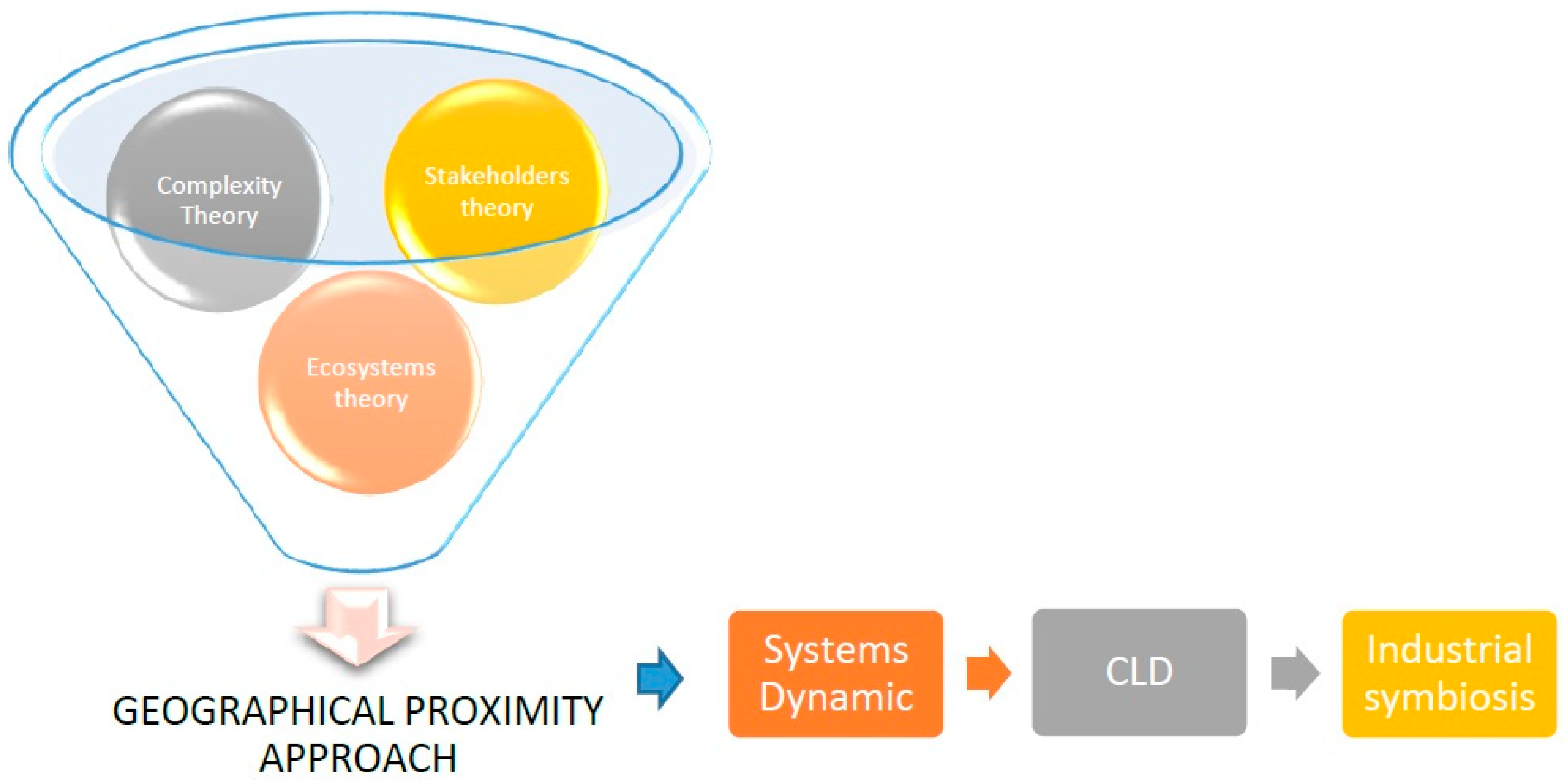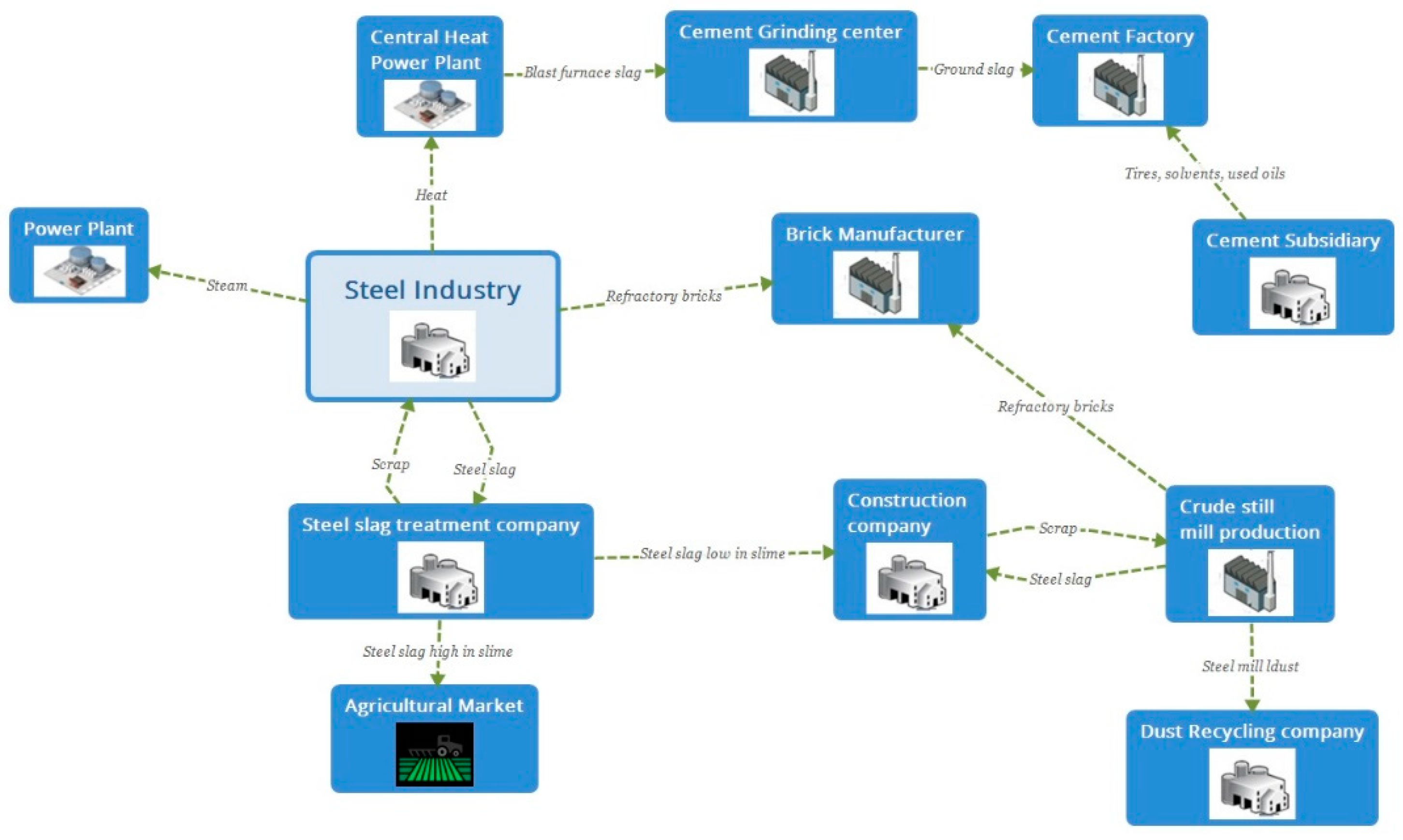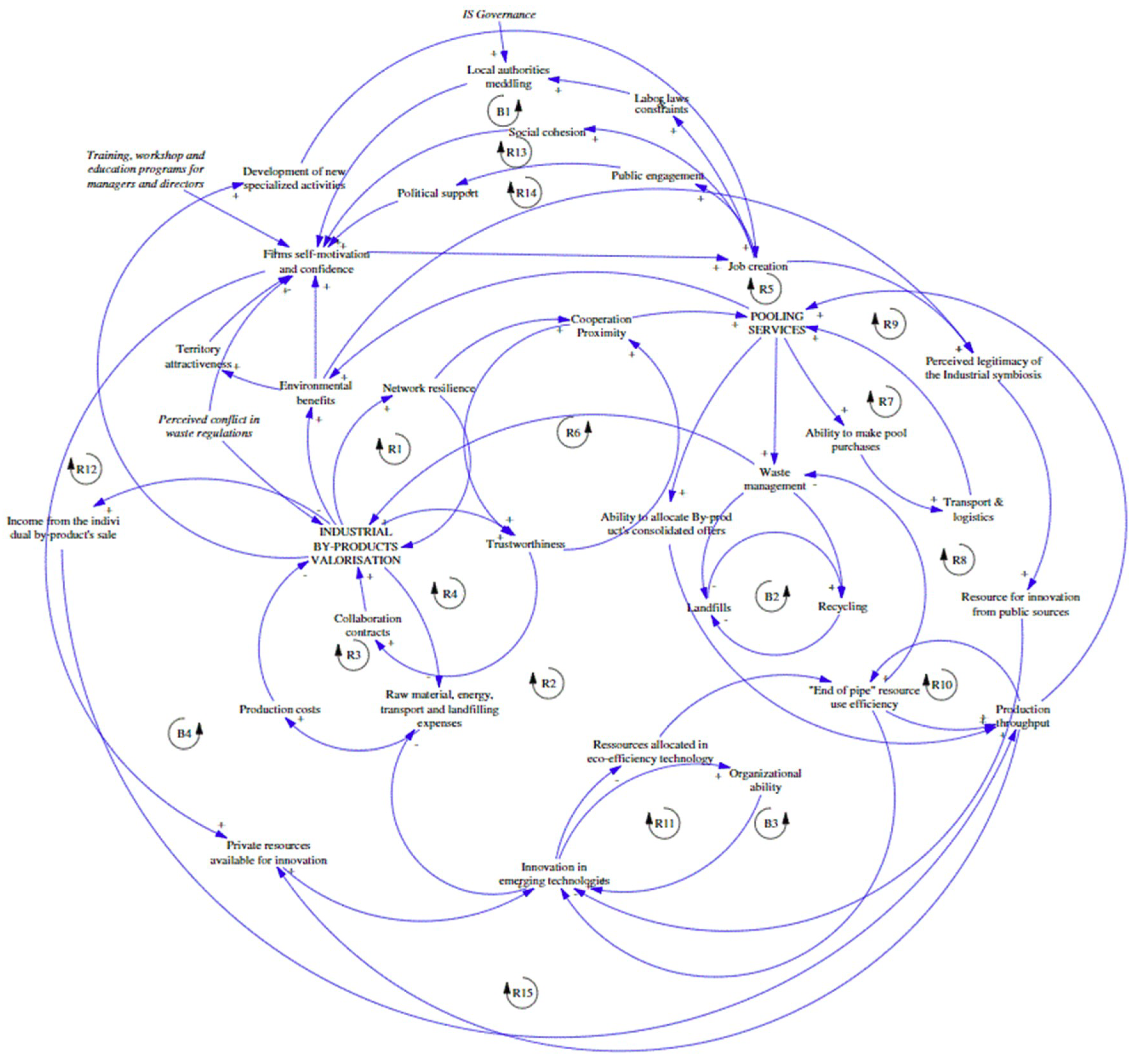Industrial Symbiosis Dynamics, a Strategy to Accomplish Complex Analysis: The Dunkirk Case Study
Abstract
:1. Introduction
1.1. Industrial Symbiosis
1.2. Dunkirk, Industrial Ecosystem Analysis
2. Theoretical Framework
2.1. Complexity Theory as an Approach to Study the Industrial Symbiosis
2.2. Economic Geography Theory as an Approach to Study Industrial Symbiosis
2.3. Ecosystem Theory as an Approach to Study Industrial Symbiosis
3. Methodology
4. Results
4.1. The Dynamics Governing Industrial Symbiosis at Dunkirk
4.2. Drivers for Industrial By-Product Valorization in Dunkirk
4.3. Hindrances to a Systemic Understanding of the Dunkirk Industrial Symbiosis
4.4. Drivers of Pooling Services Innovation in the Dunkirk Industrial Symbiosis
4.5. Proposed Leverage Points and Interventions
5. Discussion
6. Conclusions
Author Contributions
Funding
Acknowledgments
Conflicts of Interest
References
- Frosch, R.A.; Gallopoulos, N.E. Strategies for Manufacturing. Sci. Am. 1989, 261, 144–152. [Google Scholar] [CrossRef]
- Nielsen, S.N. What has modern ecosystem theory to offer to cleaner production, industrial ecology and society? The views of an ecologist. J. Clean. Prod. 2007, 15, 1639–1653. [Google Scholar] [CrossRef]
- Hess, G. L’écosystème industriel. Difficulté épistémologique d’une telle analogie. Nat. Sci. Soc. 2009, 17, 40–48. [Google Scholar] [CrossRef]
- Tsujimoto, M.; Kajikawa, Y.; Tomita, J.; Matsumoto, Y. A review of the ecosystem concept–Towards coherent ecosystem design. Technol. Forecast. Soc. Chang. 2018, 136, 49–58. [Google Scholar] [CrossRef]
- Boons, F.; Spekkink, W.; Isenmann, R.; Baas, L.; Eklund, M.; Brullot, S. Comparing industrial symbiosis in Europe: Towards a conceptual framework and research methodology. In International Perspectives on Industrial Ecology; Edward Elgar: London, UK, 2015; pp. 69–88. [Google Scholar] [CrossRef]
- Boons, F.; Spekkink, W.; Mouzakitis, Y. The dynamics of industrial symbiosis: A proposal for a conceptual framework based upon a comprehensive literature review. J. Clean. Prod. 2011, 19, 905–911. [Google Scholar] [CrossRef]
- Chertow, M.R. Uncovering industrial Symbiosis. J. Industrial Ecol. 2007, 11, 11–30. [Google Scholar] [CrossRef]
- Mirata, M. Experiences from early stages of a national industrial symbiosis programme in the UK: Determinants and coordination challenges. J. Clean. Prod. 2004, 12, 967–983. [Google Scholar] [CrossRef]
- Walls, J.L.; Paquin, R.L. Organizational Perspectives of Industrial Symbiosis: A Review and Synthesis. Organ. Environ. 2015. [Google Scholar] [CrossRef]
- Salmi, O. Eco-efficiency and industrial symbiosis—A counterfactual analysis of a mining community. J. Clean. Prod. 2007, 15, 1696–1705. [Google Scholar] [CrossRef]
- Liu, Z.; Adams, M.; Cote, R.P.; Geng, Y.; Li, Y. Comparative study on the pathways of industrial parks towards sustainable development between China and Canada. Resour. Conserv. Recycl. 2018, 128, 417–425. [Google Scholar] [CrossRef]
- Leurent, M.; Da Costa, P.; Sylvestre, S.; Berthélemy, M. Feasibility assessment of the use of steam sourced from nuclear plants for French factories considering spatial configuration. J. Clean. Prod. 2018, 189, 529–538. [Google Scholar] [CrossRef]
- Diemer, A.; Labrune, S. L’écologie industrielle: Quand l’écosystème industriel devient un vecteur du développement durable. Développement Durable Territ. 2007, 1–26. [Google Scholar] [CrossRef]
- Saavedra, Y.M.B.; Iritani, D.R.; Pavan, A.L.R.; Ometto, A.R. Theoretical contribution of industrial ecology to circular economy. J. Clean. Prod. 2018, 170, 1514–1522. [Google Scholar] [CrossRef]
- Jedelhauser, M.; Binder, C.R. The spatial impact of socio-technical transitions—The case of phosphorus recycling as a pilot of the circular economy. J. Clean. Prod. 2018, 197, 856–869. [Google Scholar] [CrossRef]
- Hampikian, Z. Structuration urbaine d’un réseau de chaleur et énergie fatale: La proximité comme variable dynamique. Flux 2017. [Google Scholar] [CrossRef]
- Beaurain, C.; Varlet, D. Régulation des interactions au sein d’un réseau territorialisé d’entreprises dans le cadre de l’écologie industrielle. 2015. Available online: http://rei.revues.org/6262 (accessed on 10 December 2018).
- Chertow, M.R. Industrial symbiosis: Literature and Taxonomy. Annu. Rev. Energy Environ. 2000, 25, 313–337. [Google Scholar] [CrossRef]
- Buclet, N. Ecologie Industrielle et Territoriale: Stratégies locales pour un Développement Durable; Presses Universitaires du Septentrion: Villeneuve d’Ascq, France, 2011. [Google Scholar]
- Buclet, N. Essai d’écologie territoriale: l’exemple d’Assois en Savoie; CNRS: Paris, France, 2015. [Google Scholar]
- Ayres, R.; Ayres, I. A Handbook of Industrial Ecology; Edward Elgar: Northampton, MA, USA, 2001. [Google Scholar]
- Boiral, O. Concilier Environnement et competitivite, ou la quete de l’eco-efficience. Revue Francaise de Gestion 2005, 31, 165–186. [Google Scholar] [CrossRef]
- Mayer, A.; Haas, W.; Wiedenhofer, D.; Krausmann, F.; Nuss, P.; Blengini, G. Measuring progress towards a Circular Economy: A monitoring framework for economy-wide material loop closing in the EU28. J. Ind. Ecol. 2019, 23, 62–76. [Google Scholar] [CrossRef]
- Beaurain, C.; Brullot, S. L’écologie industrielle comme processus de développement territorial: Une lecture par proximité. Rev. D’economie Régionale Urbaine 2011, 2, 313–340. [Google Scholar] [CrossRef]
- Freeman, R. Strategic Management: A Stakeholder Approach; Pitman Publishing: London, UK, 1984. [Google Scholar]
- Hein, A.M.; Jankovic, M.; Feng, W.; Farel, R.; Yune, J.H.; Yannou, B. Stakeholder power in industrial symbioses: A stakeholder value network approach. J. Clean. Prod. 2017, 148, 923–933. [Google Scholar] [CrossRef]
- Beaurain, C.; Varlet, D. Some tracks of reflection for a pragmatic approach of industrial ecology: The example of the urban area of Dunkirk. Rev. Développement durable et territoires 2014, 5, 1. [Google Scholar] [CrossRef]
- Kasmi, F.; Laperche, B.; Merlin-Brogniart, C.; Burmeister, A. Écologie Industrielle, milieu Innovateur et Gouvernance Territorial; Le cas de Dunkerque: Dunkerque, France, 2017. [Google Scholar]
- Boutillier, S.; Laperche, B.; Uzunidis, B. Rapport Le Territoire Entrepreneurial Durable: Etude du cas de Dunkerque (Nord-France); Institut CDC pour la Recherche: Paris, France, 2015. [Google Scholar]
- Bennich, T.; Belyazid, S.; Kopainsky, B.; Diemer, A. The bio-based economy: Dynamics governing transition pathways in the Swedish forestry sector. Sustainability 2018, 10, 976. [Google Scholar] [CrossRef]
- Ostrom, E.; Basurto, X. Crafting analytical tools to study institutional change. J. Inst. Econ. 2011, 7, 317–343. [Google Scholar] [CrossRef]
- Morin, E. Le Paradigme perdu: La Nature Humaine; Editions du Seuil: Paris, France, 1973. [Google Scholar]
- Morin, E. La Methode; Editorial du Seuil: Paris, France, 1977. [Google Scholar]
- Morin, E. Introduction a la Pensée Complexée; Editorial du Seuil: Paris, France, 2005. [Google Scholar]
- Patrucco, P.P. Collective knowledge production costs and the dynamics of technological systems. Econ. Innov. New Technol. 2009, 18, 296–310. [Google Scholar] [CrossRef]
- Diemer, A.; Morales, M.E. rfdd-2016-HS4—Morales Diemer (1). Revue Francophone Du Développement Durable 2016, (Special issue 4), 52–71. [Google Scholar]
- Bridge, G.; Bouzarovski, S.; Bradshaw, M.; Eyre, N. Geographies of energy transition: Space, place and the low-carbon economy. Energy Policy 2013, 53, 31–340. [Google Scholar] [CrossRef]
- Morales, E.M.; Diemer, A.; Cervantes, G.; Carrillo-González, G. By-product synergy” changes in the industrial symbiosis dynamics at the Altamira-Tampico industrial corridor: 20 Years of industrial ecology in Mexico. Resourc. Conserv. Recycl. 2019. [Google Scholar] [CrossRef]
- Erkman, S. Vers une Ecologie Industrielle: Comment Mettre en Pratique le Développement durable dans une Société Hyper-Industrielle; Charles Léopold Mayer: Paris, France, 2004. [Google Scholar]
- Durlauf, S. Complexity and Empirical Economics. Econ. J. 2005, 115, 225–243. [Google Scholar] [CrossRef]
- Forrester, J. Industrial Dynamics; MIT Press: Cambridge, MA, USA, 1961. [Google Scholar]
- Forrester, J. Urban. Dynamics; MIT Press: Cambridge, MA, USA, 1970. [Google Scholar]
- Meadows, D.; Meadow, D.; Randers, J.; Behrens, W., III. Limits to Growth; Potomac Associates-Universe: New York, NY, USA, 1972. [Google Scholar]
- Duret, B. Premiers retours d’expériences en écologie industrielle: Études de cas en Europe et en Amérique du Nord; Cahiers de la Chaire d’écologie industrielle CREIDD, Université de Troyes: Troyes, France, 2005. [Google Scholar]
- Association Orée. Recueil des démarches d’écologie industrielle et territorial; Département énergie et climat-ARENE-IAU îdF: Paris, France, 2013. [Google Scholar]
- Freeman, R. The politics of Stakeholder Theory. Bus. Ethics Q. 1994, 4, 409–421. [Google Scholar] [CrossRef]
- Passet, R. La Gestion des Ressources de la planète: L’approche Économique; Cahiers Français: Paris, France, 1991. [Google Scholar]
- Metereau, R.; Figuière, C. Ecologie industrielle. Le secteur agroalimentaire comme point de départ pour une organisation écosystémique des activités humaines. In Ecologie Industrielle et Territorial; Dans, G.J., Brullot, S., Eds.; Presses des Mines: Paris, France, 2015; pp. 215–232. [Google Scholar]
- Joubert, J.; Brullot, S. Etudes des dimensions sociales des démarches d’écologie industrielle et territorial. Quelle méthode pour quel type de résultats? In Ecologie Industrielle et Territorial; Dans, G.J., Brullot, S., Eds.; Presses des Mines: Paris, France, 2015; pp. 33–44. [Google Scholar]
- Dunkerque Promotion. Dunkerque Promotion: Agence de Promotion Economique. Available online: www.dunkerquepromotion.org (accessed on 22 December 2018).
- Diemer, A. Qu’avons-nous appris des symbioses industrielles? In Ecologie Industrielle et Territorial; Dans, G.J., Brullot, S., Eds.; Presses des Mines: Paris, France, 2015; pp. 173–186. [Google Scholar]
- Agence d’Urbanisme et Développement de la Région Flandres-Dunkerque. Retrieved from La Toile Industrielle de Dunkerque. Available online: http://www.agur-dunkerque.org/etudes-projets/article13 (accessed on 22 November 2018).
- Boons, F.; Baas, L. Industrial symbiosis in a social science perspective. In Proceedings of the Discussion Proposals for the Third Industrial Symbiosis Research Symposium 2006, Birmingham, UK, 5–6 August 2006. [Google Scholar]



| Dimension | Concept | Example |
|---|---|---|
| Location | Refers to the absolute and relative proximity. Due to their transformative character, socio-technical innovations change the location of social and material system entities. | Fossil energies in transport systems in the 19th century, increased relative proximity between cities with access to railway but on the other hand, reduced the relative proximity between cities and rural without access to the railway. |
| Landscape | Refers how the analyses of socio-technical innovations affect and transform land. | Wind turbines and solar panel constructions; need to emphasize that they bring place-attached emotions and social representations. |
| Territoriality | Socio-technical systems are spatially determined, encompassing the exertion of power through place-, space- and scale-related governance structures. Three dimensions of territoriality can be identified: contiguity, connectivity and centralization. | Contiguity describes geographical density. that is, transnational energy grids have low contiguity, whereas industrial symbiosis entails high contiguity. Connectivity refers to the points of connection within a system. Centralization refers to the socio-spatial governance distribution degree, that is, a gas pipeline has few connection points (low connectivity), together with few decision points (high centralization). |
| Scaling | Instrumental variable shedding light on the reconfiguration capacity of socio-technical innovations in terms of who is affected by and who benefits from, a given strategy. | According to their interests, some actors aim to foster local resource cycles through industrial symbiosis, while others might seek to implement (supra-)national recycling systems. |
| Spatial differentiation and uneven development | Refers to the differences between places, defining how the location and landscape produce intra- and inter-systemic spatial structures and so winners and losers and facilitate or hamper fundamental socio-technical change. | Socio-technical innovations based on common regulations and standards might promote regional convergence, although they might lead to spatial differentiation resulting in uneven regional development. |
| Spatial embeddedness and path dependency | Refers to capital and institutions such as standards and social practices, not just affecting the systems’ exchange potential but also inducing path dependency. | The investment that public authorities make in non-renewable fuels infrastructure determines the paths of future energy investments, locking into some alternatives based on decisions made in the past. |
| Geographic Dimension | Dunkirk Industrial Symbiosis |
|---|---|
| Location | Absolute: Short distances in most synergy exchanges Relative: Increase of proximity between the industrial park and the town |
| Landscape | Potential problems regarding public acceptance |
| Territoriality | High decentralization of actors during by-product valorisation and consumption High contiguity of by-product consumers and pooling services industries (local industrial ecosystem) |
| Scaling | Local/regional by-product valorisation and recycling |
| Spatial differentiation and uneven development | Re-working of local and regional core/periphery patterns |
| Spatial embeddedness and path dependency | Lock-in of waste regulations and standards. Path dependencies due to an existing eco-efficiency expertise and networks between industrial managers and local authorities. |
© 2019 by the authors. Licensee MDPI, Basel, Switzerland. This article is an open access article distributed under the terms and conditions of the Creative Commons Attribution (CC BY) license (http://creativecommons.org/licenses/by/4.0/).
Share and Cite
Morales, M.E.; Diemer, A. Industrial Symbiosis Dynamics, a Strategy to Accomplish Complex Analysis: The Dunkirk Case Study. Sustainability 2019, 11, 1971. https://doi.org/10.3390/su11071971
Morales ME, Diemer A. Industrial Symbiosis Dynamics, a Strategy to Accomplish Complex Analysis: The Dunkirk Case Study. Sustainability. 2019; 11(7):1971. https://doi.org/10.3390/su11071971
Chicago/Turabian StyleMorales, Manuel E., and Arnaud Diemer. 2019. "Industrial Symbiosis Dynamics, a Strategy to Accomplish Complex Analysis: The Dunkirk Case Study" Sustainability 11, no. 7: 1971. https://doi.org/10.3390/su11071971
APA StyleMorales, M. E., & Diemer, A. (2019). Industrial Symbiosis Dynamics, a Strategy to Accomplish Complex Analysis: The Dunkirk Case Study. Sustainability, 11(7), 1971. https://doi.org/10.3390/su11071971






